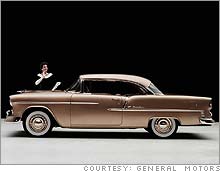|
Chevrolet of tomorrow: Back to the '50s
GM's mass-market brand wants to turn back the clock to the days when exciting design sold cars.
NEW YORK (CNNMoney.com) - There was a time when a big Chevrolet was considered cool. With fins, chrome and lots of style and flash, 1950s models like the Bel Air were made to be noticed. "Chevrolet used to be the exciting affordable car," said Jim Hall with the automotive marketing consultancy AutoPacific.
Chevrolet is still affordable. But exciting? Not quite. Today's Chevrolets, even executives at General Motors will admit, do not inspire pounding hearts and raw desire. The brand's most successful products, its SUVs and trucks, dazzle only through sheer size. Even otherwise good cars, like the Impala sedan, have the visual excitement of a decent sport coat. Now GM is looking back to the 1950s for inspiration as it tries to recover from declining market share and a seemingly unbreakable reliance on cash incentives to sell cars. Not that future Chevrolets will necessarily sprout tail fins or dozens of pounds of glittering chrome, but they won't look like every other car on the road. "For a while there I think there was a feeling that people who bought Chevrolets cared about a lot of things but they didn't care a lot about design," said Tom Wilkinson, communications director for GM design. Eye-catching design has certainly worked for the Chrysler Group of DaimlerChrysler. Cars like the Chrysler 300 and Dodge Magnum sell well without heavy incentives. Both cars are proportioned to look as if they could have driven straight out of a comic book. But, those cars are not intended for mass appeal. They are designed for strong appeal among a relative few. The same can be said for GM's Hummer and Cadillac divisions, which have also used a more radical design approach to appeal to those who really want to stand out in a crowd. But what about a car like the Chevrolet Impala, one of GM's most popular cars? Hundreds of thousands of Impalas are sold every year to consumers and fleet buyers like police departments. Are those buyers likely to want flash and style in their big family car? "Something that's well designed doesn't have to be radically designed," said Wilkinson. The change
Expect the change to start in the next couple of years. While no images of the vehicles have been publicly released yet, a look ahead at upcoming Saturns and a look back at the classic Chevys of the 1950s gives an idea of the sort of thing Wilkinson is talking about. And, some experts say, it's just what Chevrolet needs in an era when building better cars just isn't enough. Saturn, GM's youngest division, has always been known for a kind and gentle dealership experience with no-haggle pricing. It has never been known for particularly desirable or interesting automobiles. Saturn's new line-up of cars, beginning with the two-seat roadster called the Sky, followed by the Aura sedan and the redesigned Vue SUV, will get a new, futuristic look. Saturn will also be introducing a larger crossover SUV called the Outlook. With these vehicles, Saturns are going to start looking very interesting. Much of the vehicles' design will be shared with GM's European Opel brand. The designs will be edgier and more artful than American buyers are used to seeing from GM. Chevrolet will get things rolling with its own version of the Aura sedan, said Hall, who was treated to a peek at the new Chevrolet sedan. He called the new Chevrolet design even more striking than the Saturn. The Saturn Aura shares its engineering underpinnings with the current Chevrolet Malibu. The next generation Malibu will be much more aggressive-looking, said GM's Wilkinson, who allowed that the current Malibu is "kind of blah." Still, improved appearances won't be enough to succeed. Cars like the Chrysler 300 and Dodge Magnum, rear-wheel-drive cars with extremely powerful optional engines, are also fundamentally different from functionally similar vehicles in their price ranges. Also, from the standpoint of driving dynamics, they perform better than most cars they compete against. Meanwhile, Toyota and other Japanese competitors are seen as having better quality and long-term durability than the Detroit-based carmakers. Although GM can legitimately claim to have narrowed the gap in quality against those competitors, that's been a tough sell with consumers. "There's a lot of sour past experiences that the domestics are going to have to get through," said James Bell, publisher of the automotive consumer guide IntelliChoice. Better design could be enough to get buyers to consider a GM vehicle when, in the past, they would have gone with a Toyota or Honda as, simply, a safer bet. "It's a question of who's got the right car at the right time," said Bell. |
|

